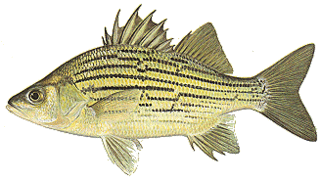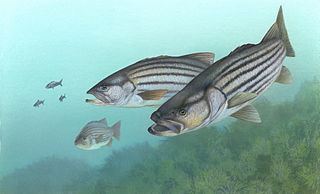Bass is a generic common name shared by many species of ray-finned fish from the large clade Percomorpha, mainly belonging to the orders Perciformes and Moroniformes, encompassing both freshwater and marine species. The word bass comes from Middle English bars, meaning "perch", despite that none of the commonly referred bass species belong to the perch family Percidae.

The white bass, silver bass, or sand bass is a freshwater fish of the temperate bass family Moronidae. commonly around 12–15 inches long. The species' main color is silver-white to pale green. Its back is dark, with white sides and belly, and with narrow dark stripes running lengthwise on its sides. It has large, rough scales and two dorsal fins. They are widely distributed across North America, inhabiting large reservoirs and rivers. When mating in the spring, they are more often found in shallow rivers, creeks, and streams. They have been introduced in some places as sport fish and also to predate on nuisance fish, such as gizzard shad. It is the state fish of Oklahoma.

The white perch is not a true perch but is a fish of the temperate bass family, Moronidae, notable as a food and game fish in eastern North America. In some places it is referred to as "Silver Bass".

The striped bass, also called the Atlantic striped bass, striper, linesider, rock, or rockfish, is an anadromous perciform fish of the family Moronidae found primarily along the Atlantic coast of North America. It has also been widely introduced into inland recreational fisheries across the United States. Striped bass found in the Gulf of Mexico are a separate strain referred to as Gulf Coast striped bass.

The black sea bass is a species of marine ray-finned fish, a sea bass from the subfamily Serraninae which is part of the family Serranidae, which also includes the groupers and anthias. It is found in the western Atlantic Ocean, where it is an important species for commercial and recreational fisheries.

The Moronidae is a family of percomorph fishes, commonly called the temperate basses, in the order Moroniformes. These fishes are found in the freshwaters of North America and the coastal waters of the North Atlantic.

Lake Anna is one of the largest freshwater inland reservoirs in Virginia, covering an area of 13,000 acres (53 km2), and located 72 miles (116 km) south of Washington, D.C., in Louisa and Spotsylvania counties. The lake is easily accessible from Fredericksburg, Richmond, Charlottesville, Northern Virginia, and Washington, D.C., and is one of the most popular recreational lakes in the state.

Bait fish are small-sized fish caught and used by anglers as bait to attract larger predatory fish, particularly game fish. Baitfish species are typically those that are common and breed rapidly, making them easy to catch and in abundant supply.

Greers Ferry Lake is the reservoir formed by Greers Ferry Dam, a United States Army Corps of Engineers dam in Northern Arkansas. It is located about 60 miles (100 km) north of Little Rock.

The yellow bass is a member of the family Moronidae. This species is a deep bodied fish that possesses five to seven dark stripes laterally along the sides, the lowest few of these are often broken or disrupted anterior to the origin of the anal fin. This species is somewhat similar to two other species in the family Moronidae, the white bass and the striped bass. The yellow bass is distinguishable from both of these species by having the offset lateral stripes above the anal fin and from not possessing tooth patches on the tongue. The yellow bass differs further from the white bass by having nine to ten anal rays in comparison to eleven or thirteen. The back of the fish is usually a dark olive green, and the abdomen and sides are often a silvery yellow.

The tiger trout is a sterile, intergeneric hybrid of the brown trout and the brook trout. Pronounced vermiculations in the fish's patterning gave rise to its name, evoking the stripes of a tiger. Tiger trout are a rare anomaly in the wild, as the parent species are relatively unrelated, being members of different genera and possessing mismatched numbers of chromosomes. However, specialized hatchery rearing techniques are able to produce tiger trout reliably enough to meet the demands of stocking programs.
Photobacterium damselaesubsp.piscicida is a gram-negative rod-shaped bacterium that causes disease in fish.

Striped bass are perciform fish found all along the Atlantic coast, from Florida to Nova Scotia. A distinct strain has historically existed in the Gulf of Mexico, but the fishery that exists there today is for stocked or reservoir-escapee fish. Striped bass are of significant value as sporting fish, and have been introduced to many areas outside their native range.

The life zones of West Virginia allow for a diversity of habitats for fauna, varying from large lowland farming valleys bordered with forest and meadow to highland ridge flats and heavy forestland, some with rocky ridge-line peaks. The "Mountain State" harbors at least 56 species and subspecies of mammals. The state has more than 300 types of birds and more than 100 species of fish.
Fishing in Colorado has brought in a large amount of revenue for the state. In 2019 Colorado Parks and Wildlife estimated outdoor recreation contributed roughly 62 billion dollars to the state economy. Fishing was reported to be the 5th most popular outdoor activity and 110, 511 fishing and hunting combination licenses were sold. Ice fishing makes up part of this total fishing revenue and is a common annual sport for Colorado residents and out-of-state visitors. There is no legal definition of ice fishing season. Rather, people begin to ice fish once the lakes freeze over with thick enough ice. Colorado Parks and Wildlife also recommend that people always ice-fish with another person. Typically, this starts in December and ends in April for Colorado. Lakes size, depth, elevation, and seasonal weather can cause variance to the season. Once the lakes freeze over with thick enough ice, anglers go out onto the ice, drill holes through the ice, and fish for a variety of species.














